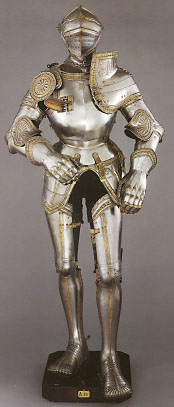
The
Golden Fleece
on 16th Century
Armor
Stephen Herold
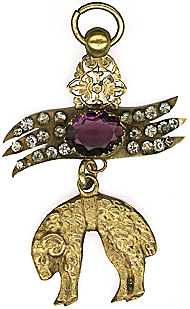 When
the order of the Golden Fleece was established a set of collars was made for
all original knights and issued to them with the requirement of return upon
their death. At first the only authorized manner of wearing the order was to
wear the collar at all times. It was a century later, under Charles V, that
the daily wearing of the fleece alone was authorized, and this was the beginning
of the bijou. The collars were of gold, and the holders of the order were knights
subject to military service. Having a soft and valuable gold collar banging
on steel armor would soon destroy the collar, so various expedients were made.
When
the order of the Golden Fleece was established a set of collars was made for
all original knights and issued to them with the requirement of return upon
their death. At first the only authorized manner of wearing the order was to
wear the collar at all times. It was a century later, under Charles V, that
the daily wearing of the fleece alone was authorized, and this was the beginning
of the bijou. The collars were of gold, and the holders of the order were knights
subject to military service. Having a soft and valuable gold collar banging
on steel armor would soon destroy the collar, so various expedients were made.
The exceptional collection in the Real Armería of the Spanish Patrimonio
Nacional in Madrid holds an unequalled set of armor examples from Maximillian
I, Philip I, Charles V and Philip II. These sets are of the highest quality
and show the accepted style as worn by the sovereign of the order himself. This
article is based on that collection.
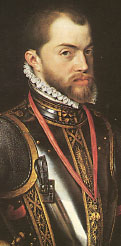
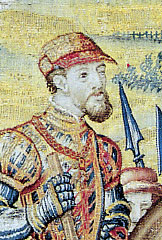 Large
bronze-gilt collars and fleeces were made for daily wearing and use with armor;
a later version of one such can be seen in the 18th century Hispanic Fleece
of the standing ram type from our insignia page (shown at upper left). Surviving
paintings indicate that the collar, too, was sometimes worn with armor. An example
is the tapestry in the Patrimonio Nacional showing Charles V reviewing his army
on its way to the seige of Tunis (shown at right). As with the famous painting
by Titian of Charles V on horseback in armor wearing a fleece, it shows the
collar worn over armor. Admittedly this was only a formal display parade where
one might wear one’s best, but it seems based on fact as the two artists
responsible for the tapestry drawings accompanied the expedition. Another example
is the painting of a young Philip II by Anthonis Mor, also shown at the right.
Here Philip wears only the fleece on a red ribbon as authorized by his father,
but over armor. We also might comment that both these paintings, even idealized
as they might be, clearly show the mis-shaped jaw that afflicted the family
for generations (discussed on our Habsburg
jaw page).
Large
bronze-gilt collars and fleeces were made for daily wearing and use with armor;
a later version of one such can be seen in the 18th century Hispanic Fleece
of the standing ram type from our insignia page (shown at upper left). Surviving
paintings indicate that the collar, too, was sometimes worn with armor. An example
is the tapestry in the Patrimonio Nacional showing Charles V reviewing his army
on its way to the seige of Tunis (shown at right). As with the famous painting
by Titian of Charles V on horseback in armor wearing a fleece, it shows the
collar worn over armor. Admittedly this was only a formal display parade where
one might wear one’s best, but it seems based on fact as the two artists
responsible for the tapestry drawings accompanied the expedition. Another example
is the painting of a young Philip II by Anthonis Mor, also shown at the right.
Here Philip wears only the fleece on a red ribbon as authorized by his father,
but over armor. We also might comment that both these paintings, even idealized
as they might be, clearly show the mis-shaped jaw that afflicted the family
for generations (discussed on our Habsburg
jaw page).
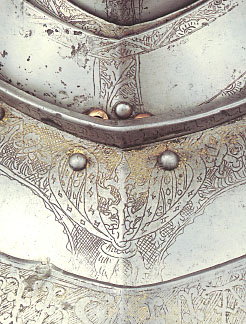 Our
first armor example is a set of Philip I, the Fair, made c. 1500 by an Italian
armorer working at the Burgundian court, likely Martin Rondelle (Inv. A II).
It has a collar of the Golden Fleece etched on the breastplate, although the
bottom part of the fleece is covered by the lower half of the sbreastplate.
The collar elements are highly stylized, and the etcher may never have seen
a real example. The Fleece is of the narrow, hanging sheepskin-like type that
alternated with the standing ram type in the early period of the Golden Fleece.
Traces of gilding remain, but this set of armor seems to have been worn and
used in battle or jousts, and it has the marks and dings of great age.
Our
first armor example is a set of Philip I, the Fair, made c. 1500 by an Italian
armorer working at the Burgundian court, likely Martin Rondelle (Inv. A II).
It has a collar of the Golden Fleece etched on the breastplate, although the
bottom part of the fleece is covered by the lower half of the sbreastplate.
The collar elements are highly stylized, and the etcher may never have seen
a real example. The Fleece is of the narrow, hanging sheepskin-like type that
alternated with the standing ram type in the early period of the Golden Fleece.
Traces of gilding remain, but this set of armor seems to have been worn and
used in battle or jousts, and it has the marks and dings of great age.
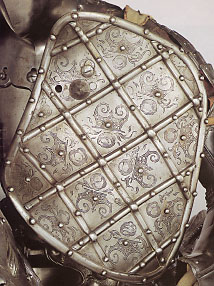 When
we move on to Charles V (Charles I of Spain) we have contemporary armor from
throughout his reign. The first is a set likely dating to 1518 and the festivities
surrounding the arrival of Charles to Spain, but before his election as Emperor
(Inv. A 37). It is attributed to Kolman Helmschmid of Augsburg, a famous armorer
who was in Imperial favor. The armor has a fleece etched at the top of the breast
plate that is very similar to the one in the next example, but it is too covered
by the decorated targe shown at the right to be easily seen. The targe is decorated
with a diaper pattern and Burgundian firesteels as used on the fleece collar
and later bijou. Perhaps the most imteresting part in this richly decorated
suit of armor is the top of the horses chanfron where two ram horns of the Golden
Fleece itself are attached (shown below) as if the horse had horns itself. This
is remiscent of the ancient world where totem animals and especially horns were
worn on armor. This is the only example I know of where the sovereign of the
Golden Fleece actually rode a (stylized) fleece in addition to wearing one.
When
we move on to Charles V (Charles I of Spain) we have contemporary armor from
throughout his reign. The first is a set likely dating to 1518 and the festivities
surrounding the arrival of Charles to Spain, but before his election as Emperor
(Inv. A 37). It is attributed to Kolman Helmschmid of Augsburg, a famous armorer
who was in Imperial favor. The armor has a fleece etched at the top of the breast
plate that is very similar to the one in the next example, but it is too covered
by the decorated targe shown at the right to be easily seen. The targe is decorated
with a diaper pattern and Burgundian firesteels as used on the fleece collar
and later bijou. Perhaps the most imteresting part in this richly decorated
suit of armor is the top of the horses chanfron where two ram horns of the Golden
Fleece itself are attached (shown below) as if the horse had horns itself. This
is remiscent of the ancient world where totem animals and especially horns were
worn on armor. This is the only example I know of where the sovereign of the
Golden Fleece actually rode a (stylized) fleece in addition to wearing one.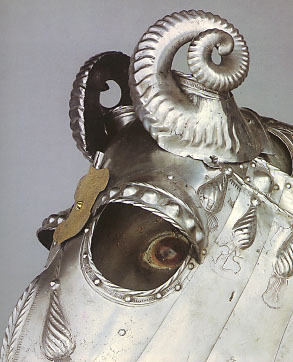
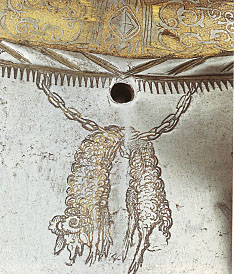 The
next example of armor of Charles V is from only a few years later around 1525
(Inv. A 19). It, too, has an etched hanging sheepskin fleece shown draped over
a simple chain. This set is also attributed to Kolman Helmschmid of Augsburg
and is known as the “KD armor” after the large, gilt “KD”
on the left shoulder plate. From its cramped location the etched fleece may
a later addition, especially as, unlike the earlier armor of Charles, the decorations
contain no elements of the Fleece or Burgundian symbols. The entire suit of
armor is shown in the illustration at the top of this page.
The
next example of armor of Charles V is from only a few years later around 1525
(Inv. A 19). It, too, has an etched hanging sheepskin fleece shown draped over
a simple chain. This set is also attributed to Kolman Helmschmid of Augsburg
and is known as the “KD armor” after the large, gilt “KD”
on the left shoulder plate. From its cramped location the etched fleece may
a later addition, especially as, unlike the earlier armor of Charles, the decorations
contain no elements of the Fleece or Burgundian symbols. The entire suit of
armor is shown in the illustration at the top of this page.
The Real Armerķa also has two more armor sets of Charles V without fleeces ( Inv.
A 149 and A 93), the first horse armor, the horses bard coming from Maximillian
I, and the second tonlet armor for the foot tourney.
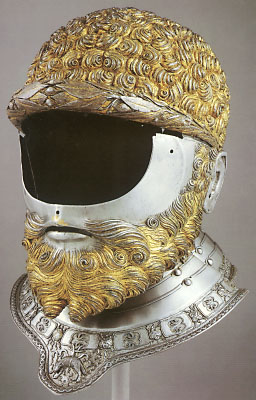 This
then brings us to one of the finest armorial fleeces of all, the steel and gold
parade helmet of Charles V (Inv. D1). The helmet (shown at right) has gilded
hair curls and an elaborate gilt beard. The curls are described in the old Spanish
register as “like those on the Golden Fleece” and show how closely
the fleece and Charles were connected. At the bottom is a chased and engraved
collar of the standing ram style (shown in detail below). Interestingly, the
collar is only found on the front half of the neckpiece, with an arabesque design
on the back half. This is original in the design as the edging border is the
same on both pieces.
This
then brings us to one of the finest armorial fleeces of all, the steel and gold
parade helmet of Charles V (Inv. D1). The helmet (shown at right) has gilded
hair curls and an elaborate gilt beard. The curls are described in the old Spanish
register as “like those on the Golden Fleece” and show how closely
the fleece and Charles were connected. At the bottom is a chased and engraved
collar of the standing ram style (shown in detail below). Interestingly, the
collar is only found on the front half of the neckpiece, with an arabesque design
on the back half. This is original in the design as the edging border is the
same on both pieces.
It is dated to 1553 and was made by Filippo Fegroli of Milan. Filippo and his
brother Francesco were leading masters of the all’antica style
of armor using ancient motifs and figures. Their employment by Charles V shows
how immersed Charles was in the sprit of the Renaissance and its Classical roots,
despite his conservative nature and his life in reactionary Spain. This helmet
is connected with a magnificent parade shield (Inv. D 2) in steel and gold that
bears no fleece, but does have the Burgundian firesteel and ragged staff elements
on its edge (shown below at bottom), as well as Charles’ personal badges
of the imperial double eagle and pillars of Hercules.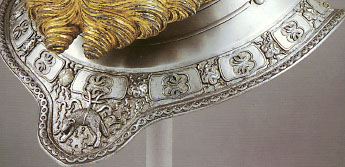
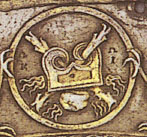 The crossed ragged staff
of Burgundy and the firesteel on the edge of Charles’ parade shield.
The crossed ragged staff
of Burgundy and the firesteel on the edge of Charles’ parade shield.
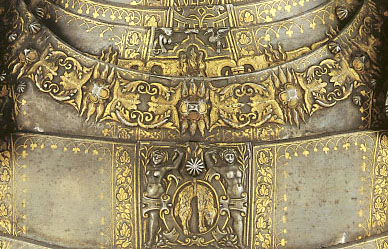 Finally
we come to the parade armor of Philip II (Inv. A 239-242) where Classical motifs
continue, even as we approach the Baroque, but the imagry is now more closely
related to the Habsburgs and their family iconography. The chased, engraved
and gilt collar is shown at the left, and it is worthy collar in any era. What
is most interesting is that it is repeated, in differing completeness, on each
of the five pieces of the neck so that it shows no matter how the armor articulates.
The armor was made by Desiderius Helmschmid of Augsburg, and the gilding was
by Jörg Sigman of the same city. It is dated to 1549-50 and 1552, a time
when Philip was still crown prince. His arms on the horse chanfron shown below,
still show the differentiating bar of a son that he will keep until his father’s
death at the end of the decade.
Finally
we come to the parade armor of Philip II (Inv. A 239-242) where Classical motifs
continue, even as we approach the Baroque, but the imagry is now more closely
related to the Habsburgs and their family iconography. The chased, engraved
and gilt collar is shown at the left, and it is worthy collar in any era. What
is most interesting is that it is repeated, in differing completeness, on each
of the five pieces of the neck so that it shows no matter how the armor articulates.
The armor was made by Desiderius Helmschmid of Augsburg, and the gilding was
by Jörg Sigman of the same city. It is dated to 1549-50 and 1552, a time
when Philip was still crown prince. His arms on the horse chanfron shown below,
still show the differentiating bar of a son that he will keep until his father’s
death at the end of the decade.
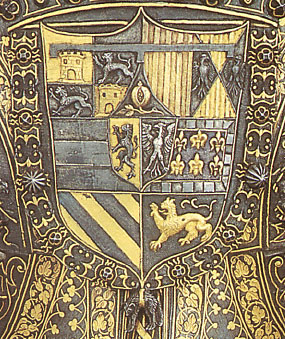 In
this set the horse armor also has a fine fleece on the top of the chanfron where
we find another collar that surrounds Philip‘s coat of arms, a style we
will see ever after with Imperial arms (shown at left).
In
this set the horse armor also has a fine fleece on the top of the chanfron where
we find another collar that surrounds Philip‘s coat of arms, a style we
will see ever after with Imperial arms (shown at left).
From this time onward the etching of orders as well decoration on armor is
general until formal armor goes out of fashion in the middle of the 18th century.
Thus we see that the difficulty of collars banging to pieces on armor was quickly
solved by application of the usual decorative techniques of etching and chasing.
For corrections or additions please contact Stephen
Herold.
Copyright © 2004 by La Confrérie Amicale.
Return to Society of the Golden Fleece
Return to the Golden Fleece Insignia Page
Antiques AtoZ Home Page
Stephen Herold - Medals, Orders & Decorations
 When
the order of the Golden Fleece was established a set of collars was made for
all original knights and issued to them with the requirement of return upon
their death. At first the only authorized manner of wearing the order was to
wear the collar at all times. It was a century later, under Charles V, that
the daily wearing of the fleece alone was authorized, and this was the beginning
of the bijou. The collars were of gold, and the holders of the order were knights
subject to military service. Having a soft and valuable gold collar banging
on steel armor would soon destroy the collar, so various expedients were made.
When
the order of the Golden Fleece was established a set of collars was made for
all original knights and issued to them with the requirement of return upon
their death. At first the only authorized manner of wearing the order was to
wear the collar at all times. It was a century later, under Charles V, that
the daily wearing of the fleece alone was authorized, and this was the beginning
of the bijou. The collars were of gold, and the holders of the order were knights
subject to military service. Having a soft and valuable gold collar banging
on steel armor would soon destroy the collar, so various expedients were made.


 Large
bronze-gilt collars and fleeces were made for daily wearing and use with armor;
a later version of one such can be seen in the 18th century Hispanic Fleece
of the standing ram type from our insignia page (shown at upper left). Surviving
paintings indicate that the collar, too, was sometimes worn with armor. An example
is the tapestry in the Patrimonio Nacional showing Charles V reviewing his army
on its way to the seige of Tunis (shown at right). As with the famous painting
by Titian of Charles V on horseback in armor wearing a fleece, it shows the
collar worn over armor. Admittedly this was only a formal display parade where
one might wear one’s best, but it seems based on fact as the two artists
responsible for the tapestry drawings accompanied the expedition. Another example
is the painting of a young Philip II by Anthonis Mor, also shown at the right.
Here Philip wears only the fleece on a red ribbon as authorized by his father,
but over armor. We also might comment that both these paintings, even idealized
as they might be, clearly show the mis-shaped jaw that afflicted the family
for generations (discussed on our
Large
bronze-gilt collars and fleeces were made for daily wearing and use with armor;
a later version of one such can be seen in the 18th century Hispanic Fleece
of the standing ram type from our insignia page (shown at upper left). Surviving
paintings indicate that the collar, too, was sometimes worn with armor. An example
is the tapestry in the Patrimonio Nacional showing Charles V reviewing his army
on its way to the seige of Tunis (shown at right). As with the famous painting
by Titian of Charles V on horseback in armor wearing a fleece, it shows the
collar worn over armor. Admittedly this was only a formal display parade where
one might wear one’s best, but it seems based on fact as the two artists
responsible for the tapestry drawings accompanied the expedition. Another example
is the painting of a young Philip II by Anthonis Mor, also shown at the right.
Here Philip wears only the fleece on a red ribbon as authorized by his father,
but over armor. We also might comment that both these paintings, even idealized
as they might be, clearly show the mis-shaped jaw that afflicted the family
for generations (discussed on our  Our
first armor example is a set of Philip I, the Fair, made c. 1500 by an Italian
armorer working at the Burgundian court, likely Martin Rondelle (Inv. A II).
It has a collar of the Golden Fleece etched on the breastplate, although the
bottom part of the fleece is covered by the lower half of the sbreastplate.
The collar elements are highly stylized, and the etcher may never have seen
a real example. The Fleece is of the narrow, hanging sheepskin-like type that
alternated with the standing ram type in the early period of the Golden Fleece.
Traces of gilding remain, but this set of armor seems to have been worn and
used in battle or jousts, and it has the marks and dings of great age.
Our
first armor example is a set of Philip I, the Fair, made c. 1500 by an Italian
armorer working at the Burgundian court, likely Martin Rondelle (Inv. A II).
It has a collar of the Golden Fleece etched on the breastplate, although the
bottom part of the fleece is covered by the lower half of the sbreastplate.
The collar elements are highly stylized, and the etcher may never have seen
a real example. The Fleece is of the narrow, hanging sheepskin-like type that
alternated with the standing ram type in the early period of the Golden Fleece.
Traces of gilding remain, but this set of armor seems to have been worn and
used in battle or jousts, and it has the marks and dings of great age. When
we move on to Charles V (Charles I of Spain) we have contemporary armor from
throughout his reign. The first is a set likely dating to 1518 and the festivities
surrounding the arrival of Charles to Spain, but before his election as Emperor
(Inv. A 37). It is attributed to Kolman Helmschmid of Augsburg, a famous armorer
who was in Imperial favor. The armor has a fleece etched at the top of the breast
plate that is very similar to the one in the next example, but it is too covered
by the decorated targe shown at the right to be easily seen. The targe is decorated
with a diaper pattern and Burgundian firesteels as used on the fleece collar
and later bijou. Perhaps the most imteresting part in this richly decorated
suit of armor is the top of the horses chanfron where two ram horns of the Golden
Fleece itself are attached (shown below) as if the horse had horns itself. This
is remiscent of the ancient world where totem animals and especially horns were
worn on armor. This is the only example I know of where the sovereign of the
Golden Fleece actually rode a (stylized) fleece in addition to wearing one.
When
we move on to Charles V (Charles I of Spain) we have contemporary armor from
throughout his reign. The first is a set likely dating to 1518 and the festivities
surrounding the arrival of Charles to Spain, but before his election as Emperor
(Inv. A 37). It is attributed to Kolman Helmschmid of Augsburg, a famous armorer
who was in Imperial favor. The armor has a fleece etched at the top of the breast
plate that is very similar to the one in the next example, but it is too covered
by the decorated targe shown at the right to be easily seen. The targe is decorated
with a diaper pattern and Burgundian firesteels as used on the fleece collar
and later bijou. Perhaps the most imteresting part in this richly decorated
suit of armor is the top of the horses chanfron where two ram horns of the Golden
Fleece itself are attached (shown below) as if the horse had horns itself. This
is remiscent of the ancient world where totem animals and especially horns were
worn on armor. This is the only example I know of where the sovereign of the
Golden Fleece actually rode a (stylized) fleece in addition to wearing one.
 The
next example of armor of Charles V is from only a few years later around 1525
(Inv. A 19). It, too, has an etched hanging sheepskin fleece shown draped over
a simple chain. This set is also attributed to Kolman Helmschmid of Augsburg
and is known as the “KD armor” after the large, gilt “KD”
on the left shoulder plate. From its cramped location the etched fleece may
a later addition, especially as, unlike the earlier armor of Charles, the decorations
contain no elements of the Fleece or Burgundian symbols. The entire suit of
armor is shown in the illustration at the top of this page.
The
next example of armor of Charles V is from only a few years later around 1525
(Inv. A 19). It, too, has an etched hanging sheepskin fleece shown draped over
a simple chain. This set is also attributed to Kolman Helmschmid of Augsburg
and is known as the “KD armor” after the large, gilt “KD”
on the left shoulder plate. From its cramped location the etched fleece may
a later addition, especially as, unlike the earlier armor of Charles, the decorations
contain no elements of the Fleece or Burgundian symbols. The entire suit of
armor is shown in the illustration at the top of this page. This
then brings us to one of the finest armorial fleeces of all, the steel and gold
parade helmet of Charles V (Inv. D1). The helmet (shown at right) has gilded
hair curls and an elaborate gilt beard. The curls are described in the old Spanish
register as “like those on the Golden Fleece” and show how closely
the fleece and Charles were connected. At the bottom is a chased and engraved
collar of the standing ram style (shown in detail below). Interestingly, the
collar is only found on the front half of the neckpiece, with an arabesque design
on the back half. This is original in the design as the edging border is the
same on both pieces.
This
then brings us to one of the finest armorial fleeces of all, the steel and gold
parade helmet of Charles V (Inv. D1). The helmet (shown at right) has gilded
hair curls and an elaborate gilt beard. The curls are described in the old Spanish
register as “like those on the Golden Fleece” and show how closely
the fleece and Charles were connected. At the bottom is a chased and engraved
collar of the standing ram style (shown in detail below). Interestingly, the
collar is only found on the front half of the neckpiece, with an arabesque design
on the back half. This is original in the design as the edging border is the
same on both pieces. 
 The crossed ragged staff
of Burgundy and the firesteel on the edge of Charles’ parade shield.
The crossed ragged staff
of Burgundy and the firesteel on the edge of Charles’ parade shield. Finally
we come to the parade armor of Philip II (Inv. A 239-242) where Classical motifs
continue, even as we approach the Baroque, but the imagry is now more closely
related to the Habsburgs and their family iconography. The chased, engraved
and gilt collar is shown at the left, and it is worthy collar in any era. What
is most interesting is that it is repeated, in differing completeness, on each
of the five pieces of the neck so that it shows no matter how the armor articulates.
The armor was made by Desiderius Helmschmid of Augsburg, and the gilding was
by Jörg Sigman of the same city. It is dated to 1549-50 and 1552, a time
when Philip was still crown prince. His arms on the horse chanfron shown below,
still show the differentiating bar of a son that he will keep until his father’s
death at the end of the decade.
Finally
we come to the parade armor of Philip II (Inv. A 239-242) where Classical motifs
continue, even as we approach the Baroque, but the imagry is now more closely
related to the Habsburgs and their family iconography. The chased, engraved
and gilt collar is shown at the left, and it is worthy collar in any era. What
is most interesting is that it is repeated, in differing completeness, on each
of the five pieces of the neck so that it shows no matter how the armor articulates.
The armor was made by Desiderius Helmschmid of Augsburg, and the gilding was
by Jörg Sigman of the same city. It is dated to 1549-50 and 1552, a time
when Philip was still crown prince. His arms on the horse chanfron shown below,
still show the differentiating bar of a son that he will keep until his father’s
death at the end of the decade. In
this set the horse armor also has a fine fleece on the top of the chanfron where
we find another collar that surrounds Philip‘s coat of arms, a style we
will see ever after with Imperial arms (shown at left).
In
this set the horse armor also has a fine fleece on the top of the chanfron where
we find another collar that surrounds Philip‘s coat of arms, a style we
will see ever after with Imperial arms (shown at left).